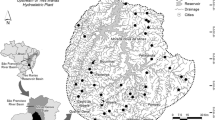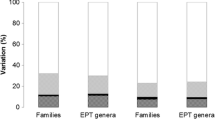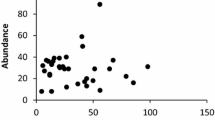Abstract
The effect of substrate heterogeneity on the structure of stream macroinvertebrate assemblages (total abundance, taxon richness, and evenness) is still not clear, but this could be due to the lack of standard methods for quantifying substrate heterogeneity. An accurate quantification of substrate heterogeneity was obtained from photographs of sampled areas (each 225 cm2), which were used to create maps that were subsequently digitized and analyzed using image analysis software. These maps allowed the calculation of multiple metrics quantifying two aspects of substrate heterogeneity: composition and spatial configuration of substrate patches. The diversity of substrate types (calculated as the Shannon diversity index), and the heterogeneity of patch compactness (calculated as the coefficient of variation of the relationship between patch dimensions) were the metrics explaining more biotic variance at the sample scale, but at higher scales there were no relationships between assemblage structure and substrate heterogeneity. Most variation in substrate heterogeneity occurred at the sample scale, while some metrics varied significantly at riffle or segment scales; these patterns of variation match those of macroinvertebrate assemblages, which had been previously studied. The importance of quantifying substrate heterogeneity and considering the spatial scales of its study are discussed.
Similar content being viewed by others
References
Beisel, J. N., P. Usseglio-Polatera & J. C. Moreteau, 2000. The spatial heterogeneity of a river bottom: a key factor determining macroinvertebrate assemblages. Hydrobiologia 422/423: 163–171.
Boyero, L., 2003. Multiscale patterns of spatial variation of stream macroinvertebrate communities. Ecol. Res. 18 (in press).
Boyero, L. & R. C. Bailey, 2001. Organization of macroinvertebrate assemblages at a hierarchy of spatial scales in a tropical stream. Hydrobiologia 464: 219–25.
Cooper, S. D., L. Barmuta, O. Sarnelle, K. Kratz & S. Diehl, 1997. Quantifying spatial heterogeneity in streams. J. N. Am. Benthol. Soc. 16: 174–188.
Cullinan, V. I. & J. M. Thomas, 1992. A comparison of quantitative methods for examining landscape pattern and scale. Landsc. Ecol. 7: 211–227.
Downes, B. J., P. S. Lake & E. S. G. Schreiber, 1993. Spatial variation in the distribution of stream invertebrates: implications of patchiness for models of assemblage organization. Freshwat. Biol. 30: 119–132.
Giller, P. S., A. G. Hildrew & D. G. Rafaelli, 1994. Aquatic ecology: scale, pattern, and process. Blackwell, London. 649 pp
Li, H. & J. F. Reynolds, 1994. A simulation experiment to quantify spatial heterogeneity in categorical maps. Ecology 75: 2446–2455.
Li, H. & J. F. Reynolds, 1995. On definition and quantification of heterogeneity. Oikos 73: 280–284.
Lindman, H. R., 1974. Analysis of variance in complex environmental designs. Freeman & Co., San Francisco.
Magurran, A. E., 1988. Ecological Diversity and its Measurement. Princeton University Press. 179 pp.
Norris, R. H., E. P. McElravy & V. H. Resh, 1992. The sampling problem. In Callow, P. & G. E. Petts (eds.), The Rivers Handbook: Hydrological and Ecological Principles. Blackwell Scientific, Oxford: 282–306.
O'Neill, R. V., J. R. Krummel, R. H. Gardner, G. Sugihara, B. Jackson, D. L. DeAngelis, B. T. Milne, B. T., M. G. Turner, B. Zygmunt, S. W. Christensen, V. H. Dale & R. L. Graham, 1988. Indices of landscape pattern. Landsc. Ecol. 1: 153–162.
Palmer, M. A., C. M. Swan, K. Nelson, P. Silver, & R. Alvestad, 2000. Streambed landscapes: evidence that stream invertebrates respond to the type and spatial arrangement of patches. Landsc. Ecol. 15: 563–576.
Pringle, C. M., R. J. Naiman, G. Bretschko, J. R. Karr, M. W. Oswood, J. R. Webster, R. L. Welcomme & M. J. Winterbourn, 1988. Patch dynamics in lotic systems: the stream as a mosaic. J. N. Am. Benthol. Soc. 7: 503–524.
Robson, B., 1996. Habitat architecture and trophic interaction strength in a river: riffle-scale effects. Oecologia 107: 411–420.
Sanson, G., T. Stolk & B. J. Downes, 1995. A new method for characterizing surface roughness and available space in biological systems. Funct. Ecol. 9: 127–135.
Stevenson, R. J., 1997. Scale-dependent determinants and consequences of benthic algal heterogeneity. J. N. Am. Benthol. Soc. 16: 248–262.
Turner, M. G. & R. H. Gardner, 1991. Quantitative methods in landscape ecology. Springer-Verlag, New York, 552 pp.
Vinson, M. R. & C. P. Hawkins, 1998. Biodiversity of stream insects: variation at local, basin and regional scales. Ann. Rev. Entomol. 43: 271–293.
Author information
Authors and Affiliations
Rights and permissions
About this article
Cite this article
Boyero, L. The quantification of local substrate heterogeneity in streams and its significance for macroinvertebrate assemblages. Hydrobiologia 499, 161–168 (2003). https://doi.org/10.1023/A:1026321331092
Issue Date:
DOI: https://doi.org/10.1023/A:1026321331092




